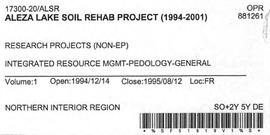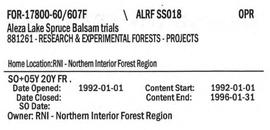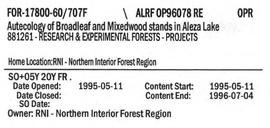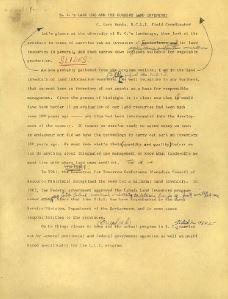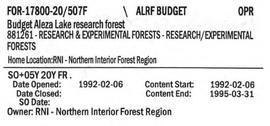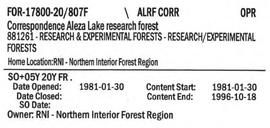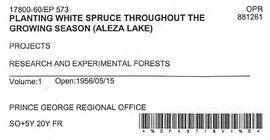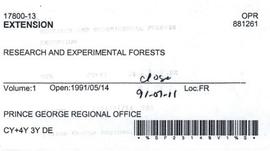Maps reflect reserve boundary, roads, trails, 20 feet contour intervals, air photo centre, declination, swamps, and mile post.
File contains charts consisting of the remeasurements of the basal area and cut stump data in permanent sample plots.
File contains handwritten journal lists of remeasured permanent sample plots and charts of remeasured permanent sample plots.
File contains research project reports and charts of remeasured permanent sample plots.
File contains typed file notes and charts of remeasured experimental plots, as well as a floppy disk
File contains official government reports on tree types, correspondence regarding research proposals, and working plans.
File contains road reconstruction project reports, photocopies of invoices and work orders, records of daily costs, photocopies of hired equipment daily time reports, related correspondence, and maps.
File consists of chainsaw-cut stump data in selected plots for June and July 1993 and May 1994.
File contains climate data of soil and air temperatures, correspondence relating to climate studies, original and photocopied receipts for items related to the study, and computer generated graphs.
File contains reports on soil rehabilitation project and related correspondence, photocopied tables of soil measurements, and photocopied pages of ledgers with diagrams and notes.
File contains reports on soil rehabilitation projects and related correspondence, photocopied tables of soil measurements, and reports on machinery costs when tilling.
File contains original tables for soil measurements, a related photocopied draft report, and related photocopied handwritten notes.
File contains photocopies of seedling measurement tables.
File contains proposal updates and project expenditure lists.
File contains photocopies of survey notes from 1954.
File contains 1996 charts of permanent sample plot remeasurements.
File contains 1991 regeneration data of permanent sample plots and a 1992 work term study report on the significance of the basal area on regeneration factors.
File consists of documents, radiograms, and correspondence regarding various administrative issues ranging from costs, living conditions, timber sales, research projects, and queries from the public. Much of this correspondence is between Tim Decie, Forester in Charge of Aleza Lake, and R.P Silsbury, Head of the Research Division between the years of 1953 and 1967. Also included are contracts and receipts from 1964, documents regarding the closure of the Aleza Lake Experiment Station, and meeting minutes.
File contains Aleza Lake Research Forest weather records from 1927 to 1934 and 1928 to 1933.
File contains reports and essays on certain research projects ranging from the year 1924 to 1984. The topics of these research projects include cutting methods, guidelines for marking techniques, and scarification.
File contains articles and government publications on the results of research projects and policies regarding the Aleza Lake Experiment Station with years ranging from 1945 to 1992. Also included are a photocopied 1926 progress report, a 1967 management manual, and guides pertaining to trails and marking stands for cutting.
File contains a 1997 field tour guide of the Aleza Lake Research Forest, and 1997 and 1998 government publications on research projects conducted at the forest.
File consists of:
- David Mills, "Aleza Lake Research Forest Historical Internship Summary" (2 Jan. 2007), 26 p. - In print and original digital .doc file
- David Mills, "Aleza Lake Forest Experiment Station Socio-Economic Time Line 1905-1937" (2007), 68 p. - In print and original digital .doc file
- ALRFS employment paperwork for David Mills, the ALRFS Natural Resource History Intern
- Research notes, including a copy of a map of the town of Aleza Lake in the 1920s
File consists of photocopies of various report front covers and references to Knox McCusker from 1926-1931.
File consists of the following items:
- "Mac" by D.L. Surveyor
- "Knox (Mac) McCusker: Dominion Land Surveyor" by E.L. Rutherford, V.C. Brink, R.S. Silver and M.Z. (Smokey) Neighbour
- Excerpts from Men and Meridians by Don W. Thomson
- Article re: Knox McCusker written on the occasion of his death (April 14, 1955)
- "McKusker (sic) to open up Blueberry Mountain Area" (Alaska Highway News, June 8, 1950)
- "McCusker was surveyor, big game guide….also rancher and trail blazer"
- "Knox Freeman McCusker" written on the occasion of his death (The Canadian Surveyor, July 1955)
- "Veteran Surveyor - Alaska Highway Stories"
- Memories of Knox McCusker by his oldest niece Betty (McCusker) Rutherford
- "Veteran Surveyor prefers horses for long bush treks" by Eric Young (Edmonton Journal)
- Eulogy for Knox McCusker read by Stanley D. Seif at Burch Presbyterian Church in Fort St. John, B.C.
- Eulogy for Gwendolyn Dorothy McCusker (July 1997)
- "Tropical Valley No Myth: amazing story of woman who lived there" by Thomas A. Wayling (Vancouver Sun)
- Photocopy of section of map: "Topographical sketch map showing route traversed by the Bedaux Sub-Arctic Expedition 1934 through the Rocky Mountains" (by Frank Swannell, March 27, 1935)
- Memories of Knox McCusker by Bill McCusker, his oldest nephew
- "There is always a reason; destiny made it a date. The corridor of the Alcan didn’t just happen" (Fort St. John publication)
- Article on Knox McCusker (ALS News, Winter 1983)
File consists of the following articles and speeches written by Knox McCusker:
- "Reminiscences of Knox McCusker" (63 typewritten pages)
- "Back and Beyond the Peace" by K.McCusker (taken from the Toronto Star Weekly Saturday May 5, 1928) – retyped
- "The Alaska Highway" by Knox F. McCusker, D.L.S. (The Canadian Surveyor, July 1943)-photocopy
- Mr. McCusker's speech (5 pages)
- “Tropical Valleys of B.C.” (4 pages)
- "The president has called me an old old surveyor…" speech written by K. McCusker
- "In the early days of my career in the Surveying profession…" written by K. McCusker
File contains correspondence relating to project funding and reports on the significance of the project.
File consists of an article written by Gary Runka entitled "Balanced Agriculture - Its Social Value" for the Symposium o n Decoupling, Ottawa - February 10-12,1988.
Commentary on this speech by Barry Smith of the Ministry of Agriculture and Lands:
"This speech was prepared for publication in the July 1988 edition of t he "Canadian Journal of Agricultural Economics".
The Symposium explores the social and economic values of agriculture and this paper primarily pursues the social value side of the equation and asserts that a healthy agricultural sector has a social as well as economic value to Canada.
The paper is broken into four sections:
(I) The Farm;
(II) Rural Communities and Regions;
(III) Canada and Beyond; and
(IV) Summary.
Under these broad topics the paper considers several themes, many of which have a strong or direct relationship to farmland preservation. B.C. and Quebec programs are directly mentioned. A few of these themes are captured here:
- "balanced agriculture" ... let it imply a balance between economic considerations (market forces) and social values
- It is not easy to design legislative programs that will accommodate both the legitimate financial concerns of those who husband the land and the desire of society to protect a scarce resource
- Society must share in t he responsibility to retain foodlands. "...both Quebec and British Columbia accepted this responsibility in their agricultural land preservation legislation by bring in associated commodity income insurance programs along with the provincial designation of land within agricultural land reserve zoning."
- A need for balance between private rights of land ownership with stewardship and the responsibility of government to intervene when private interests do not coincide with public interests.
- The urban majority will have a growing influence on the way farmers and agriculture will be treated in coming decades
- Any country is wise to ensure that it retains the option to produce at least a portion of its own food
- Do we want agriculture driven by a "trade environment" or do we as a country have other social goals that we wish to pursue, of which international trade is part?
- It is in Canadian society's general interest to have economic and social cohesion when considering agricultural policy reform."
File consists of a speech given by Gary Runka entitled "BC Experience: Establishing Priorities for the Use of Rural Land Resources" for the Canadian Institute of Planners Annual Conference in Kitchener, Waterloo.
Commentary on this speech by Barry Smith of the Ministry of Agriculture and Lands:
"This is a second speech GGR gave at the 1980 CIP Conference.
The 'rural' stage is set by stating that BC is 94% crown land of which 53% is unreserved crown land - so lots of rural land to plan for.
The paper largely outlines 8 examples of rural land use priorities in BC including:
- Integrating rural land use policy under the Environment and Land Use Act
- Agricultural Land Commission Act protecting farmland
- Forest and Range Act
- Municipal and Regional government community, settlement and regional plans - largely on non-crown land
- The Federal government's amended Fisheries Act
- Special Statutes Planning - The Islands Trust Act
- Crown land Planning Strategies
- Environment Planning via an Environment Act, Water Basin Plan and Wildlife along with complimentary legislation.
The paper helps to place the farmland preservation in the context with other land use planning efforts in British Columbia."
File consists of a speech given by Gary Runka entitled "BC Land Use Issues and Smiling Frogs" for the Agricultural Institute of Canada Foundation.
Commentary on this speech by Barry Smith of the Ministry of Agriculture and Lands:
"This presentation, which was accompanied by slides (not with speaking notes) reviews five diverse land use issues of which three involve agriculture, two of which were directly linked to the ALC.
The 'Smiling Frogs' metaphor is wonderfully explained as the heat is turned up and down on land use issues and complacency is something to be avoided.
GGR was directly involved in some capacity with each of the issues reviewed and, therefore is in a position to provide an "insiders" point of view. The five issues were:
- Burnaby Business Park (Burnaby Big Bend) - Lower Mainland - a very succinct overview is provided for this win-win accomplishment which directly involved ALC decision-making.
- Charlotte-Alplands (West Chilcotin) - involved an exploration of forest, recreation and wilderness tourism opportunities and the identification of potential conflicts.
- Fraser River Delta (Delta Farmland and Wildlife Trust) - considers the successful coming together of agricultural and wildlife interests in an area that has both internationally significant wildlife habitat and an important part of the Pacific Flyway but also comprises one of the best agricultural areas in Canada.
- Mid-Coast (Greenpeace and Western Forest Products) - provides insights into a very hot issue that had some success and some failure in trying to get two very opposed sides together in which the Land and Coastal Resource Management Planning process is struggling.
- Six Mile Ranch (Kamloops) - every so often the ALC is faced with what might be referred to as an application of province wide notoriety and Six Mile Ranch assuredly fit this description. The application involved a proposal in the Kamloops area (but some distance from Kamloops) to use an area of interior grasslands ALR for urban development in the form of residential, resort and golf course. GGR sums up his feelings nicely on this land issue - "My involvement in this fiasco is indirect and that of "Citizen Runka" and perhaps more specifically as a student of government stupidity."
File consists of a speech given by Gary Runka entitled "BC Soil Conservation Issues: How Serious are They?" for a BCFA Soil Conservatiori Seminar - March 10,1987.
Commentary on this speech by Barry Smith of the Ministry of Agriculture and Lands:
"Stressing the importance of soil conservation, this speech begins by noting that all land and water users (not just agriculture) - on-site or off-site - are involved with soil conservation.
The paper is broken into 3 sections:
(1) Framework Considerations in which the diversity of BC's landform and climate is noted. The key soil conservation issues from a provincial perspective are reviewed including:
- erosion;
- sedimentation;
- acidification;
- organic matter loss; and
- soil compaction.
(2) Economic Considerations - the estimated loss annually in agriculture due to soil erosion is 30 to 50 million dollars.
(3) Legislation and Institutional Structure Considerations - BC is noted as having no provincial legislation that has soil conservation as its main thrust.
While the ALC Act and ALR are not directly mentioned, soil conservation is an important associated issue related to farmland preservation."
File consists of a speech given by Gary Runka entitled "BC's Agricultural Land Reserve - Its Historical Roots" at the Post World Planners Congress Seminar.
Commentary on this speech by Barry Smith of the Ministry of Agriculture and Lands:
"Vancouver hosted the World Planners Congress in June 2006 and the day following the Congress the BC Ministry of Agriculture and Lands and Agriculture and Agri-Food Canada hosted a full day seminar entitled "Planning for Food".
GGR provided an important overview of the BC farmland preservation program. The speech begins with comments outlining the factors motivating the government of the day to enact legislation to preserve agricultural land. The presentation was then broken into three time periods including:
The Formative Years (1972-1975)
The Refinement Years (1976-1996)
The Uncertain Years (1996-????)
GGR in his summary poses some less than optimistic questions and observations. He states that despite successes "there are growing
concerns that, over its history, the focus of the program has subtly shifted - from an agency devoted to farmland preservation, to a rationing board." He sees the focus on application review as being detrimental to the Commission's role of promoting and encouraging farming in the ALR. Given this shift in direction he presents several suggestions to get the program back on track.
The presentation ends with a challenge to the people of B.C. to decide whether the next segment of the B.C. farmland preservation history is entitled 'The Rebuilding Years' or not."
File consists of a speech given by Gary Runka entitled "BC's Land Use and the Current Land Inventory".
Commentary on this speech by Barry Smith of the Ministry of Agriculture and Lands:
"Although page 4 of this speech is missing (or possibly intentionally deleted), this document provides a detailed explanation of the CLI ratings and may well have been the basis of interpretation guidelines for agricultural capability mapping used by the ALC.
GGR at the time was the B.C. Land Inventory Field Coordinator.
It appears that slides at one point accompanied this speech."
File consists of climate station data printed from computer disks, original and photocopied soil description forms, and original copies of ecological and terrain mapping reports.
File consists of budget proposals and forecasts for 1993/94 and 1994/95 with recommendations of road maintenance as the central expenditure.
File consists of documents relating to the construction of the Pacific Great Eastern Railway (PGE), which predominantly consist of photocopy reproductions, excerpts from books, and clippings from periodicals. Includes a chronology of the history of PGE, a list of sub-contractors who completed the Squamish sub-division, "PGE/BCR: Dease Lake Extension First 25 Years, 1968 to 1993", and "P.G.E.R. 1914 to 1923: Progressive Dates of Commencement of Passenger Service".
Photographs are panoramas taken from the Churchill BC Forest Service Lookout, located at latitude 54°04' and longitude 122°16'. The photographs were bound together and include a transparent grid that was intended to be used for locating forest fires.
File contains reports on the analysis of permanent sample plots in the Aleza Lake Research Forest.
File consists of a speech given by Gary Runka entitled "Consensus Decision Making" for an Executive Development Program.
File consists of photocopies of 1960s records from the City of Prince George related to Island Cache that were organized by researchers involved with the Island Cache Recovery Project. Includes an Urban Renewal Report and municipal memoranda.
File contains general correspondence from 1981 through 1998 regarding various administrative issues including road maintenance and the 1992 reopening of the Aleza Lake Research Forest. The file also contains a 1994 inventory of the Northwood donation to the Fraser-Fort George Museum.
File consists of a speech given by Gary Runka entitled "Effects of Urban Decision Making on Rural Issues".
Commentary on this speech by Barry Smith of the Ministry of Agriculture and Lands:
"The introduction begins by stating that urban-oriented people are making decisions that impact on rural issues and land / people relationships. This paper provides a perspective largely from a rural point of view although, at the very end it is concluded that people in rural areas are often unaware of the dynamics of urban needs and priorities.
While the examples of urban influences on rural areas are too numerous to comprehensively outline even in a 16 page speech, GGR does cover a lot of ground in this regard in the paper. He feels that through careful planning built on understanding we can, as a society, achieve a comfortable balance.
The question is asked, who is rural and who is urban - there is a degree of blurring. The paper considers urban decision-making in the broadest context - whether political, economic or social.
The paper is broken into a consideration of urban decision making and its effects on rural areas from a number of points of view - (1) Political; (2) Economic; and (3) Lifestyle.
It is noted that there is a need for greater understanding of agriculture from both a rural and urban point of view and the spin-offs of food and fibre production in providing jobs in the urban community is not widely recognized by urban citizens or elected officials.
As the number of urbanites take up residence in rural areas their power at the local ballot box also increases. Three examples of urban decision making on rural issues are explored including:
(1) The "Killer" Mall;
(2) The "Suburban" Horse; and
(3) Soil Conservation.
Interdependence is specifically emphasized - there is seldom any decision taken that does not impact to some degree somewhere else along the urban-rural continuum."
File contains photocopies of a study on seed production in coniferous trees for a period over 7 years.
File contains studies of scattered plantation trials throughout the area, which includes Summit Lake, Giscome, Buckhorn Lake, Groundbirch, Aleza lake, and Pinchi Lake.
File contains photocopies of handwritten notes and measurement charts, correspondence regarding various administrative concerns, and research project reports.
File contains photcopies of progress reports, the final study on the project, maps of the studied plot, and measurement tables.
File consists of a speech given by Gary Runka entitled "Expanding Needs from a Finite Resource: the Necessity for Sound Land Use Planning" for the Manitoba Land Use Conference Land User for the 80's - Private Rights and Public Interests, March 11 & 12,1981.
Commentary on this speech by Barry Smith of the Ministry of Agriculture and Lands:
"The conference theme of "Private Rights and Public Interests" is one that GGR often turned to. In this fairly lengthy speech GGR pulls together, in one paper, many of the themes and positions he has turned to in other speeches. He explains the 'land and water maze' and lists 12 uses competing for limited land and water resources. It is noted that the imbalance between agriculture vs urban uses, due to urban uses commanding much higher values resulting in agriculture finding itself in a defensive position, is discussed.
As the conference theme enunciates - GGR explores the tug-of-war between the myth of limitless land and community needs vs property rights and the fallacy that individual land use decisions do not impact the larger community. GGR emphasises the slowness of changing attitudes and the even slower political response and policy change. The confusion of jurisdiction concerning what level of government is best positioned to deal with resources issues is considered. GGR emphasizes the need to plan the use of land resources in an integrated and comprehensive fashion and the need for shared decision making.
Policy 3 of Manitoba's Regulation #217/80 - "Rural residential development should not be thought of, nor normally planned, as an evolutionary step from a rural landscape to an urban development" is noted. It is emphasized that the planning process has to catch up with the rural reality.
Central message - the importance of planning land and water use must be in keeping with the natural characteristics of the land and the needs and values of the local community. This latter point is of interest from the point of view that local community values and plans may dash with provincial values or policy."
File contains orginal and photocopied correspondence relating to silviculture field courses and graphs pertaining to volume and diameter changes.
File consists of memoranda from Per Saxvik to Bell-Irving regarding "Fraser River Flow Analysis with Reference to Fish Passage Capacity through the Main Fishways at Hell's Gate". Also includes a "Fraser River Canyon Fish Passage Summary Report (June 1988) Updated October 1989" by Per Saxvik of SEP Engineering.
File consists of a speech given by Gary Runka entitled "Future of Intensive Livestock Enterprises in the more densely populated areas of the Agricultural Land Reserve" for the Agricultural Engineering Branch of the BC Ministry of Agriculture.
Commentary on this speech by Barry Smith of the Ministry of Agriculture and Lands:
"In the letter dated December 29,1978, from GGR to Pat Brisbin (Secretary, Engineering Science Lead Committee), GGR refers to the enclosure as "the notes pertaining to my submission" that presumably was made at a meeting of the Engineering Science Lead Committee on December 21,1978.
The thrust of this item is to address the matter of intensive livestock farming in areas within close proximity to urban uses - e.g. in the ALR and along the urban / rural edge.
The 'notes" include a list of twelve "considerations" that should be taken into account when dealing with livestock enterprises on the urban edge.
Six 'actors' and their responsibilities are identified including:
- The Agricultural Land Commission;
- Ministry of Agriculture;
- Local Governments;
- BC Federation of Agriculture;
- Intensive Livestock Operators; and
- Non-farming Public.
It is emphasized that there is a need for communications between these actors and a need for education to avoid conflicts but makes clear that intensive agriculture shall be retained in the ALR.
The paper ends with a series of considerations - Philosophical / Social and Political Pressure / Financing and Tenure / Environmental - Pollution / Waste Disposal.
This paper demonstrates the long standing nature of concerns associated with intensive livestock operations near urban areas and the need for "edge planning"."
